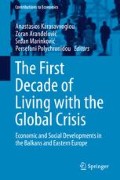Abstract
Our paper’s objective is to study the volatility of exchange rates from the region that have not yet adopted the Euro and are not members of the Exchange Rate Mechanism II by considering the exchange rate regime and the implications of currency volatility for foreign capital flows. We model exchange rate volatility by using standard deviations of daily logarithmic changes in the exchange rates, rolling standard deviations, Hodrick-Prescott filters to detect the trends in volatility and ARIMA models. We find that currency volatility remains a strong issue for these countries and that central banks have attempted to manage it, particularly after the global financial crisis. Spikes in monthly volatility are identified for all currencies, although with some variation in time. Over the long-run, some exchange rates experienced sudden increases in volatility over the entire period, but rather quickly corrected, while others have shown an episode of high volatility at the beginning of the period and recorded a reasonable level of volatility throughout the remaining period. Exchange rate volatility “has memory”, but some exchange rates are more prone to the persistent effects of shocks in volatility.
Access this chapter
Tax calculation will be finalised at checkout
Purchases are for personal use only
References
Bollerslev T (1986) Generalized autoregressive conditional heteroskedasticity. J Econ 31:307–327
Box GPE, Jenkins GM (1978) Time series analysis: forecasting and control. Holden Day, San Francisco, CA
Bugar G, Maurer R (2002) International equity portfolios and currency hedging: the view point of German and Hungarian investors. Asian Bull 32:171–197
Cont R (2005) Volatility clustering in financial markets: empirical facts and agent-based models. http://www.proba.jussieu.fr/pageperso/ramacont/papers/clustering.pdf. Accessed 10 Apr 2014
Coudert V, Couharde C, Mignon V (2011) Exchange rate volatility across financial crises. J Bank Financ 35:3010–3018
Engle R (1982) Autoregressive conditional heteroscedasticity with estimates of the variance of United Kingdom inflation. Econometrica 50:987–1008
Eun CS, Resnick BG (1994) International diversification of investment portfolios, US and Japanese perspective. Manag Sci 40:140–160
Hodrick R, Prescott EC (1997) Postwar U.S. business cycles: an empirical investigation. J Money Credit Bank 29:1–16
Horobet A, Tusa E (2007) Exchange rate volatility in Central and Eastern Europe. Rev Fac St Econ Anal Univ Oradea XVI:381–385
Horobet A, Dumitrescu DG, Dumitrescu (Raileanu) AS (2011) Investors’ exposure to currency risk in Central and Eastern Europe: are turbulent times Different? Bus Rev Cambridge 18:124–131
International Monetary Fund (2013) Annual report on exchange arrangements and exchange restrictions 2013. IMF, Washington, DC
Jorion P (1985) International portfolio diversification with estimation risk. J Bus 58:259–278
Josifidis K, Allegret JP, Beker PE (2009) Monetary and exchange rate regimes changes: the cases of Poland, Czech Republic, Slovakia and Republic of Serbia. Panoeconomicus 2:199–226
Kocenda E, Valachy I (2006) Exchange rate volatility and regime change: a visegrad comparison. J Comp Econ 34:727–753
Mellet A (2011) BRICS currency volatility: confusion or indecision? Stud Univ Babes-Bol 56:74–92
Sosic V, Kraft E (2004) Floating with a large life-jacket: monetary and exchange rate policies in Croatia. http://urrutiaelejalde.org/files/2012/01/Vujcic2.pdf. Accessed 11 Apr 2014
Author information
Authors and Affiliations
Corresponding author
Editor information
Editors and Affiliations
Rights and permissions
Copyright information
© 2016 Springer International Publishing Switzerland
About this chapter
Cite this chapter
Horobet, A., Belascu, L., Barsan, AM. (2016). Exchange Rate Volatility in the Balkans and Eastern Europe: Implications for International Investments. In: Karasavvoglou, A., Aranđelović, Z., Marinković, S., Polychronidou, P. (eds) The First Decade of Living with the Global Crisis. Contributions to Economics. Springer, Cham. https://doi.org/10.1007/978-3-319-24267-5_11
Download citation
DOI: https://doi.org/10.1007/978-3-319-24267-5_11
Published:
Publisher Name: Springer, Cham
Print ISBN: 978-3-319-24266-8
Online ISBN: 978-3-319-24267-5
eBook Packages: Economics and FinanceEconomics and Finance (R0)

